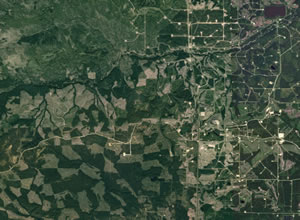Natural and human-caused disturbances are increasingly putting forest health and use at risk. Individually, these disturbances affect forest ecosystems. When combined, greater “cumulative effects” to the environmental, cultural, social and economic values derived from forested areas can occur.

Map data @2019 Google
The many natural and human-caused events that disturb forested areas include:
- wildland fires
- forest pest infestations
- climate change
- resource development (e.g. forestry, mines, oil and gas, agriculture)
- linear disturbances (e.g. roads, pipelines, seismic-exploration lines)
- recreation and human activity
- urban expansion
As part of its national program, the Canadian Forest Service (CFS) has released a series of publications to connect the work of CFS researchers addressing cumulative effects in Canada’s forests.
Understanding cumulative effects
The science of cumulative effects involves analyzing how landscape disturbances interact with each other. Researchers look at whether these interactions are positive or negative and measure the risk to the environment. They also determine how multiple disturbances change the forest by examining indicators such as tree health and threatened species.
Natural resources are a major component of Canada’s economy. Each resource sector must understand how their activities interact with other activities sharing the same landscape. When forest ecosystems are affected, these impacts extend into rural forest-based communities. The economies and regional well-being of these communities are linked to the health and productivity of local forests.
An example of the importance of cumulative effects research is the woodland caribou (Rangifer tarandus caribou) in Canada’s forests. Woodland caribou live in old and dense forests. These forests have an abundant amount of food (lichen) and few predators (wolves). However, forest harvesting and replanting have created young forests that are preferred by moose and deer, which attract wolves. Oil and gas activity has also created thousands of kilometers of exploration trails and associated access roads. These fragmented landscapes provide wolves with an easier access through older, dense forests. The accumulation of these effects has resulted in increased wolf predation and a significant negative impact on woodland caribou populations. The recovery of woodland caribou populations requires a collaborative effort among multiple partners working together and informed by cumulative effects research in order to reduce the impacts.
Cumulative effects management and Canadian Forest Service expertise
Research at the Canadian Forest Service (CFS) includes a national program on cumulative effects. By understanding the accumulated impacts of landscape disturbances in the boreal forest, decision-making related to the sustainable use of Canada’s natural resources is better informed.
A 10-year national research agenda guide is comprised of two key components.
- Understanding, assessing and reducing risk of cumulative effects
- CFS researchers are developing strategies and tools to assess, prevent and minimize the risks and impacts of cumulative effects on forests. However, there are gaps in knowledge and data for understanding, assessing, predicting and managing the cumulative effects of resource development projects. Canada’s natural resource sectors must close these gaps to uphold their strong environmental reputation as well as meet global trade and demand standards.
- The CFS works with national partners, jurisdictions, Indigenous communities and other stakeholders. These collaborations help determine the issues, needs, science gaps and opportunities.
- The impact of cumulative effects on the rights and interests of Indigenous peoples must be considered given the Government of Canada’s commitments to reconciliation. Indigenous knowledge and values can play an important role, alongside western science, in informing natural resource management decision-making.
- Creating and developing knowledge and tools to restore forest ecosystems
- CFS researchers are developing evidence-based tools and techniques to improve land reclamation and forest landscape restoration. These processes are necessary to return damaged ecosystems to their original state or into a sustainable landscape.
- Current restoration work includes improving habitat quality for the woodland caribou. This work requires on-going collaboration and engagement with both renewable and non-renewable natural resource sectors and other federal departments.
Climate change is one of the biggest factors driving the impacts of cumulative effects in Canada’s forests. The ultimate challenge in cumulative effects research is to understand how these impacts unfold with a changing climate.